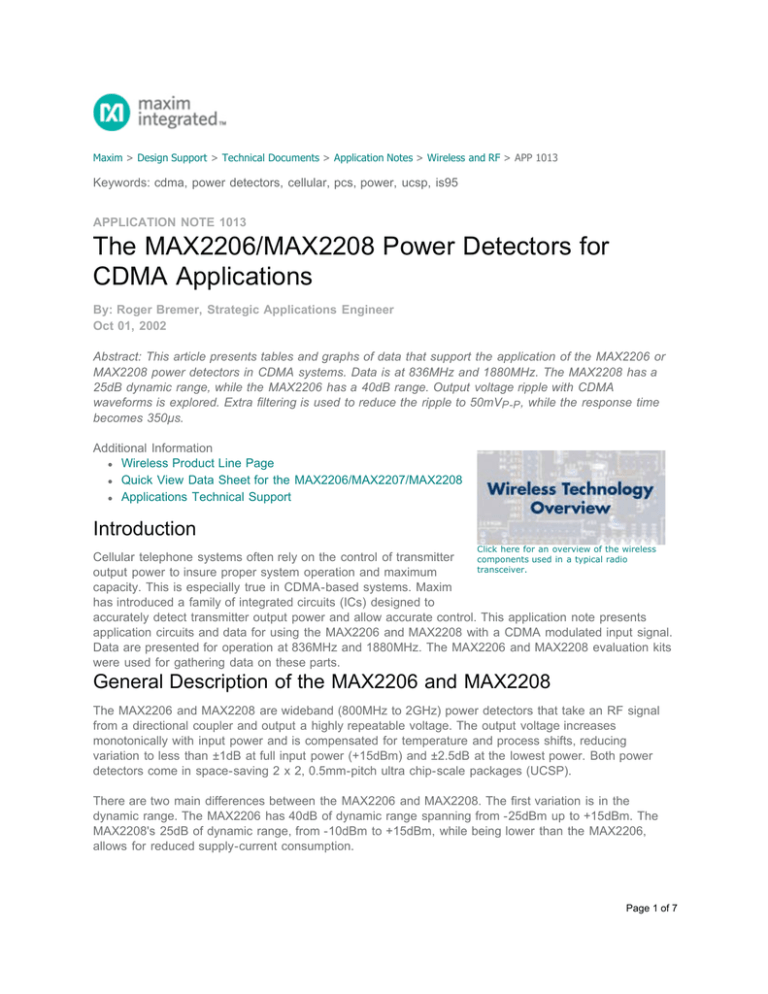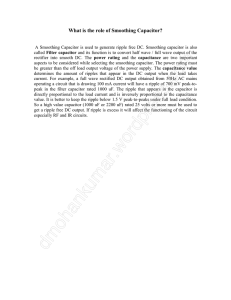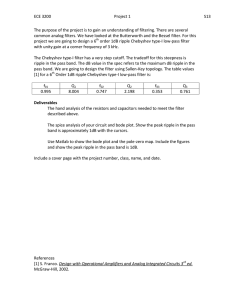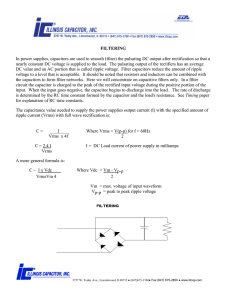The MAX2206/MAX2208 Power Detectors for CDMA
advertisement

Maxim > Design Support > Technical Documents > Application Notes > Wireless and RF > APP 1013 Keywords: cdma, power detectors, cellular, pcs, power, ucsp, is95 APPLICATION NOTE 1013 The MAX2206/MAX2208 Power Detectors for CDMA Applications By: Roger Bremer, Strategic Applications Engineer Oct 01, 2002 Abstract: This article presents tables and graphs of data that support the application of the MAX2206 or MAX2208 power detectors in CDMA systems. Data is at 836MHz and 1880MHz. The MAX2208 has a 25dB dynamic range, while the MAX2206 has a 40dB range. Output voltage ripple with CDMA waveforms is explored. Extra filtering is used to reduce the ripple to 50mVP-P , while the response time becomes 350µs. Additional Information Wireless Product Line Page Quick View Data Sheet for the MAX2206/MAX2207/MAX2208 Applications Technical Support Introduction Click here for an overview of the wireless Cellular telephone systems often rely on the control of transmitter components used in a typical radio transceiver. output power to insure proper system operation and maximum capacity. This is especially true in CDMA-based systems. Maxim has introduced a family of integrated circuits (ICs) designed to accurately detect transmitter output power and allow accurate control. This application note presents application circuits and data for using the MAX2206 and MAX2208 with a CDMA modulated input signal. Data are presented for operation at 836MHz and 1880MHz. The MAX2206 and MAX2208 evaluation kits were used for gathering data on these parts. General Description of the MAX2206 and MAX2208 The MAX2206 and MAX2208 are wideband (800MHz to 2GHz) power detectors that take an RF signal from a directional coupler and output a highly repeatable voltage. The output voltage increases monotonically with input power and is compensated for temperature and process shifts, reducing variation to less than ±1dB at full input power (+15dBm) and ±2.5dB at the lowest power. Both power detectors come in space-saving 2 x 2, 0.5mm-pitch ultra chip-scale packages (UCSP). There are two main differences between the MAX2206 and MAX2208. The first variation is in the dynamic range. The MAX2206 has 40dB of dynamic range spanning from -25dBm up to +15dBm. The MAX2208's 25dB of dynamic range, from -10dBm to +15dBm, while being lower than the MAX2206, allows for reduced supply-current consumption. Page 1 of 7 An integrated filter is included in the MAX2208. This filter allows average-power detection, which is necessary when working with CDMA modulated signals. The MAX2206 does not have such a filter, and therefore requires an external filter to accurately detect such signals. CDMA Application A key parameter to consider when using a power detector in a CDMA application is the ripple noise on the output voltage. This noise appears on the output voltage because CDMA modulation produces a nonconstant amplitude envelope. System specifications determine the maximum acceptable ripple from the power detector. Using the on-chip filter of the MAX2208 may not meet this specification. In order to decrease ripple noise, a shunt capacitor can be placed on the output of the IC. This capacitor increases the time constant of the output filter, thus decreasing the bandwidth of the lowpass filter and subsequently lessening the output ripple voltage. Table 1 presents data taken from a MAX2208 with a 1500pF output capacitor. Table 1. The MAX2208 Performance Data with a 1.5nF Output Capacitor 836MHz 1880MHz PIN (dBm) VOUT (mV) Ripple Noise (mV P-P )¹ VOUT (mV) Ripple Noise (mV P-P )¹ 15 1606 44 1643 49 13 1247 36 1291 35 11 965 29 997 29 9 741 23 765 24 7 562 19 577 20 5 427 16 439 17 3 325 15 335 15 1 245 14 254 13 -1 186 12 192 11 -3 141 12 146 10 -5 109 11 113 10 -7 86 11 89 10 -9 70 10 72 10 -11 59 10 60 10 Page 2 of 7 Figure 1. The MAX2208 performance data. When using the MAX2206, there is no integrated output filter. To average the output voltage so that CDMA signals can be properly detected, an external lowpass filter composed of a resistor and a capacitor is added to the circuit's output pin. The filter bandwidth is reduced by increasing the values of the resistor and capacitor comprising the output filter. A narrower filter bandwidth reduces the ripple amplitude. Results from a typical implementation of the MAX2206 are presented in Table 2. Table 2. The MAX2206 Performance Data with a 1.5kΩ Series Output Resistor and a 6.8nF Shunt Output Capacitor 836MHz 1880MHz PIN (dBm) VOUT (mV) Ripple Noise (mV P-P )¹ VOUT (mV) Ripple Noise (mV P-P )¹ 15 1558 47 1296 45 13 1264 37 1031 34 11 1036 29 818 27 9 856 23 651 21 7 717 19 523 17 5 613 16 426 14 3 535 13 354 12 1 476 11 299 11 -1 433 10 257 10 -3 415 10 228 10 -5 375 10 207 10 -7 349 10 190 10 -9 319 10 174 10 Page 3 of 7 -11 283 10 158 10 -13 242 10 141 10 -15 200 10 122 10 -17 160 10 103 10 -19 126 10 85 10 -21 98 10 69 10 Figure 2. The MAX2206 performance data. The reduction of ripple does not come without expense. The price paid is that of increased response time; there is a tradeoff which must be made between response time and ripple noise. The required response time of most CDMA systems is not very restraining, typically less than 500µs. Ripple noise can be reduced to within system specifications while still meeting this response time. For example, without any external filtering, the MAX2208 has a response time of 15µs. Adding an additional output capacitor to reduce maximum ripple noise to 50mVP-P increases response time to 350µs. Which Part Is Best for My Application? The first step in answering this question is to determine the power range to be detected. The power range is determined by the RF power being sensed and the coupling value of the directional coupler. The greater the coupling numerical value, the lower the RF power delivered to the detector. High coupling values or wide dynamic range makes the MAX2206 the best choice, as it can detect 15dB lower power than the MAX2208. The other factor distinguishing which part to use is the circuit board area that the power detector will occupy. The MAX2206 needs an extra resistor on the output, which increases the area occupied by the power detector. If space is a critical factor in the design, then the MAX2208 allows for a more compact Page 4 of 7 design. Measured Data For the measurements in this application note, output component values were based upon design parameters of less than 500µs response time while achieving ripple noise of under 50mVP-P . In order to decrease the output ripple in the MAX2208, a 1.5nF shunt capacitor was placed on the output (see Figure 3). For the MAX2206, an RC network consisting of a 15kΩ series resistor and a 6.8nF shunt capacitor was implemented (see Figure 4). Figure 3. The MAX2208 evaluation kit schematic. Page 5 of 7 Figure 4. The MAX2206 evaluation kit schematic. Response time for the MAX2208 with less than 50mVP-P ripple noise was measured at 350µs. For the MAX2206, response time was measured at 240µs. Input signal modulation: CDMAONE (IS95) Reverse Link, 1% Pk-Avg = 3.9dB Notes: In the test setup used, the noise floor for ripple noise measurements was 10mVP-P . Recorded values of 10mVP-P are solely measurements of outside noise and are thus not indicative of the power detector's performance. Related Parts MAX2206 RF Power Detectors in UCSP MAX2208 RF Power Detectors in UCSP Page 6 of 7 More Information For Technical Support: http://www.maximintegrated.com/support For Samples: http://www.maximintegrated.com/samples Other Questions and Comments: http://www.maximintegrated.com/contact Application Note 1013: http://www.maximintegrated.com/an1013 APPLICATION NOTE 1013, AN1013, AN 1013, APP1013, Appnote1013, Appnote 1013 Copyright © by Maxim Integrated Products Additional Legal Notices: http://www.maximintegrated.com/legal Page 7 of 7





